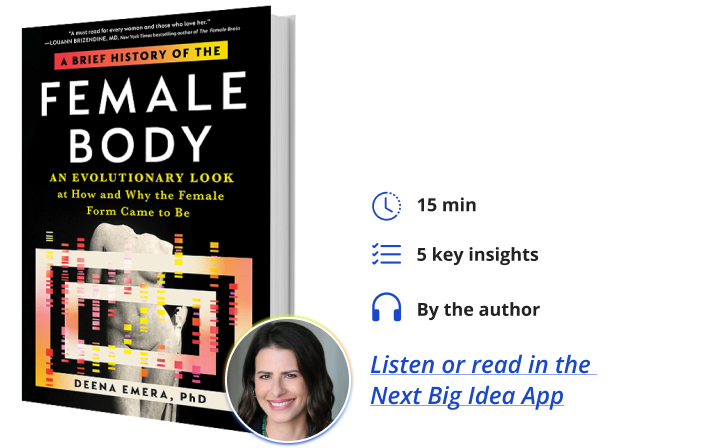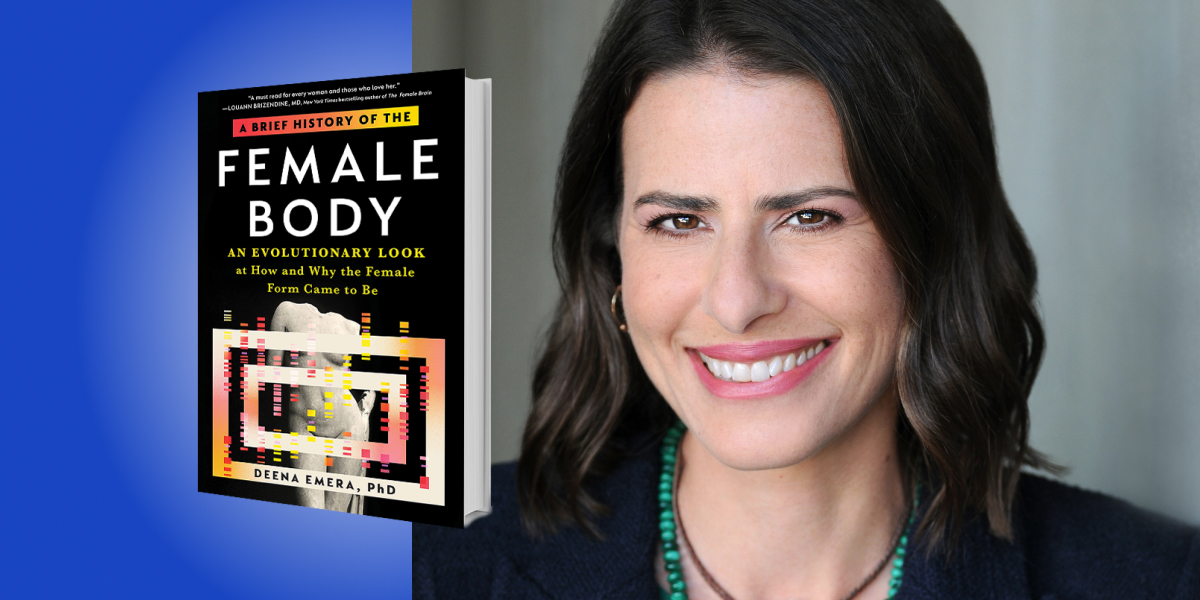Dr. Deena Emera is an evolutionary geneticist, author, and teacher. She received her master’s in human evolution at NYU. At Yale, where she received her Ph.D., she studied the evolution of pregnancy, periods, and labor in mammals and humans. She then studied at the Yale School of Medicine, where she was awarded a fellowship from the National Institute of Health to continue investigating evolutionary mechanisms.
Below, Deena shares 5 key insights from her new book, A Brief History of the Female Body: An Evolutionary Look at How and Why the Female Form Came to Be. Listen to the audio version—read by Deena herself—in the Next Big Idea App.

1. We are related to all organisms on the planet, including chimpanzees, elephants, eagles, and even fish.
Humans think of ourselves as totally unique in the animal world, but we share so much of our biology with other animals. Just as you might share traits with your cousins because you have the same grandparents, we share many traits with our animal relatives. Female monkeys, apes, and humans get periods because we share a common ancestor. Female mammals produce milk for young offspring because we share a common ancestor. Female vertebrates have reproductive cycles regulated by similar hormones because we share a common ancestor.
Knowing what we share (and don’t share) with other animals helps us understand our own biology better, and it gives us a deeper respect for the relatives with whom we share our planet.
2. We can solve the mysteries of our bodies by considering our female relatives and ancestors.
Have you ever wondered why women get periods, why pregnancy is so difficult, or why we go through menopause? We find clues to these mysteries by looking at which of our sisters in the animal world have these same experiences. Investigations like this can tell us when, how, and why these traits evolved in our ancestors.
“The evolution of menopause is a big topic.”
Let’s take an example: menopause. In primates, mid-life menopause is unique to humans (but it is experienced by a few social whale species, which is a clue). The evolution of menopause is a big topic, but we can tackle a simple question here: Why do women experience menopause but not men? Male mammals produce sperm throughout their adult lives, but female mammals do it differently—we produce all our eggs during fetal development. This sets up the conditions for menopause in females who live long enough—we run out of eggs. So why don’t we use the male strategy of continuous production so that we don’t run out?
The trait of making eggs during fetal development probably evolved for a good reason in our long-ago ancestors. It keeps eggs from accruing the damaging mutations that occur when cells replicate. Males can make sperm into old age because they have sperm stem cells that replicate indefinitely, but these cells accumulate mutations with time (which is why most mutations enter the human gene pool through males). Female mammals typically invest much more in making offspring (think pregnancy) and raising offspring (think lactation) than males, so it makes sense that we would evolve a strategy that reduces the chance of using unhealthy eggs. In fact, female animals have many of these strategies in place, such as screening for healthier sperm and embryos.
3. Both cooperation and conflict begin during pregnancy.
Most of us are familiar with the kinds of environmental challenges, like high altitude and cold weather, that drive evolutionary change, but did you know that social forces also played a role in the evolution of the female body? In our human ancestors, the ongoing process of choosing mates for reproduction led to the evolution of human body ornaments like large breasts in females (and large, dangling external genitalia in males). Also fascinating are the ancient negotiations between mothers and offspring that influenced how pregnancy and our reproductive systems evolved.
The connection between mother and baby during pregnancy is the closest there is between two people. The baby’s placenta invades the mother’s uterus to gain access to her blood supply; the mother allows the baby to do this. The evolution of pregnancy and live birth, which happened over 150 million years ago in mammals, required genetic cooperation between mothers and offspring to establish the connection and keep it working. This new way to develop babies worked out well for placental mammals, which is one of the most diverse and successful groups on the planet.
“Because parents are not genetically identical to their offspring, they don’t have identical interests.”
But once babies figured out how to tap into the mother’s blood supply, the opportunity for conflict emerged. Because parents are not genetically identical to their offspring, they don’t have identical interests. The intimate connection during pregnancy provides an arena for these conflicts of interest to play out in a tug-of-war over resources that has been going on for millions of years. In our species, these conflicts of interest help explain why we’re susceptible to so many issues during pregnancy, like preeclampsia and gestational diabetes. They may also explain other aspects of our biology, like our monthly periods and the timing of weaning and puberty.
4. Women face many health challenges because we live in a rapidly changing world, but still have the bodies of our ancestors.
Why do we get breast cancer? Why do we suffer from autoimmune disorders? Why do we struggle with our weight? To answer these questions, we need to keep in mind that our bodies evolved on the order of millions of years, but our cultures evolved on the order of hundreds of years. Genes don’t change as quickly as culture, so our bodies still expect the conditions in which our ancestors lived.
Our ancestors spent most of their adult lives pregnant and nursing, they were frequently infected with parasitic worms, and they didn’t have a steady supply of food. Our solutions to these issues today, such as better sanitation to rid our bodies of parasitic worms, may have introduced different problems, such as autoimmune disorders. An important step in improving women’s health is understanding these mismatches between our ancient bodies and modern lifestyles.
5. We can use evolutionary knowledge to build a healthier and more empowered future for women (and men).
Because we share so much of our biology with other animals, we have gained a wealth of knowledge about how our own bodies function at the cellular, organ, and whole system level by studying other animals. We have been able to do basic and preclinical research using the appropriate animal models.
“An important step in improving women’s health is understanding these mismatches between our ancient bodies and modern lifestyles.”
For health conditions that are difficult to treat, evolutionary insights are helping us come up with novel treatment options. Autoimmune disorders are notoriously difficult to treat, almost 10 percent of people suffer from them, and a whopping 80 percent of cases are found in women. The hypothesis that autoimmune disorders are prevalent because we’ve removed parasitic worms from our bodies has led to the testing of worm-inspired drugs to treat these disorders. In another example, recent work has found an interesting connection between the evolution of the placenta in different mammals and their susceptibility to cancer, which has stimulated a new line of research into better cancer therapies.
We can also study females in other species that have naturally solved some of the health challenges we face. Giraffes have very high blood pressure (both in the non-pregnant and pregnant state) to pump blood to their brains, but they do not suffer the consequences of high blood pressure as we do. Female bowhead whales continue ovulating past the age of 100, unlike human females who go through menopause at 50, which triggers a cascade of negative health effects in our bones, brains, and cardiovascular systems. Understanding how females in other species naturally avoid these conditions may lead to new preventative and therapeutic strategies in our own species. The animal world is a rich source of fascinating, useful, and even lifesaving knowledge for our own species.
To listen to the audio version read by author Deena Emera, download the Next Big Idea App today:































